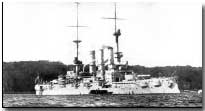Battles - The Battle of Jutland, 1916
 The greatest naval battle of the First World War. Jutland had all the ingredients to be a great
British naval victory, but in the event the result was much less clear-cut.
The greatest naval battle of the First World War. Jutland had all the ingredients to be a great
British naval victory, but in the event the result was much less clear-cut.
The recently appointed commander of the German High Seas Fleet, Reinhard Scheer, had returned to the policy of making sorties against the British coast, confident that his codes were secure, and thus that the main British battle fleet, at Scapa Flow in the north of Scotland could not intervene. However, the British could read German coded messages, and were aware of Scheer's plan.
At the end of May, Scheer sortied with the entire High Seas Fleet, expected that the only serious threat he would meet was Admiral Beatty's battle cruiser squadron based on the Forth. Unfortunately for his plan, the Royal Navy knew he was coming, and the Grand Fleet sailed only minutes after the High Seas Fleet.
Both fleets sailed in a similar formation, with a scouting squadron of battle cruisers sailing ahead of the main battle fleets. The battle falls into five main phases. The first came when Admiral Beatty, commanding the British battle cruisers encountered their weaker German equivalent under Admiral Hipper, (31 May) and chased them south towards the main German fleet.
The second phase saw Beatty flee north, pursued by the German Dreadnoughts. So far, both sides thought the battle was going to plan, although a design flaw led to the destruction of two British battle cruisers. Now, in the third phase the Germans got a nasty surprise. Thinking themselves involved in a chase that would end with the destruction of the British battle cruisers, they found themselves under bombardment from Jellicoe's battle fleet, which they had thought to be too far north to intervene.
The heavy British guns quickly forced Scheer to order a retreat, but then Scheer made what could have turned into a grievous error, turning back, possibly hoping to pass behind Jellicoe, and escape into the Baltic.
However, Jellicoe had slowed down, and the German fleet found themselves crossing in front of the British fleet, and in ten minutes of gunfire suffered 27 heavy hits while only inflicted two. Once again, Scheer ordered a retreat.
 Finally, in the last phase
of the battle, in a night of intense fighting, the retreat of the German
battleships was covered by their lighter ships, while Jellicoe lost time
after turning to avoid a potential torpedo attack.
Finally, in the last phase
of the battle, in a night of intense fighting, the retreat of the German
battleships was covered by their lighter ships, while Jellicoe lost time
after turning to avoid a potential torpedo attack.
The Germans lost one battle cruiser, one pre-Dreadnought, four light cruisers and five destroyers, while the British lost three battle cruisers, four armoured cruisers, and eight destroyers. However, many of the surviving German heavy ships had suffered serious damage, and one result of the battle was to increase the British dominance in heavy ships.
Jutland was the last, and largest, of the great battleship battles. Neither submarines or aircraft played any part in the battle, despite the plans of both sides. Never again did battle fleets meet again in such numbers. While the Royal Navy suffered more loses, the battle effectively ended any threat from the High Seas Fleet, which now knew it could not contest control of the North Sea with the Royal Navy.
The great fleet which Kaiser Wilhelm II had been obsessed with, and which had done so much to sour relations between Britain and Germany had proved to be a blunted weapon. Despite that, the battle disappointed in Britain, where news of a new Trafalgar had been expected, and the hard fought draw at Jutland was not appreciated until much later, while the Kaiser claimed a German victory.
Article contributed by John Rickard, website.
Photographs courtesy of Photos of the Great War website
Click here to read the initial official German reaction to the battle; click here to read the first British report; click here to read naval minister Eduard von Capelle's official report; click here to read British Grand Fleet Commander-in-Chief Sir John Jellicoe's report; click here to read an account of the battle by a German sailor; click here to read a British memoir.
'Strafing' is attacking ground troops by machine guns fired from low-flying aircraft.
- Did you know?
